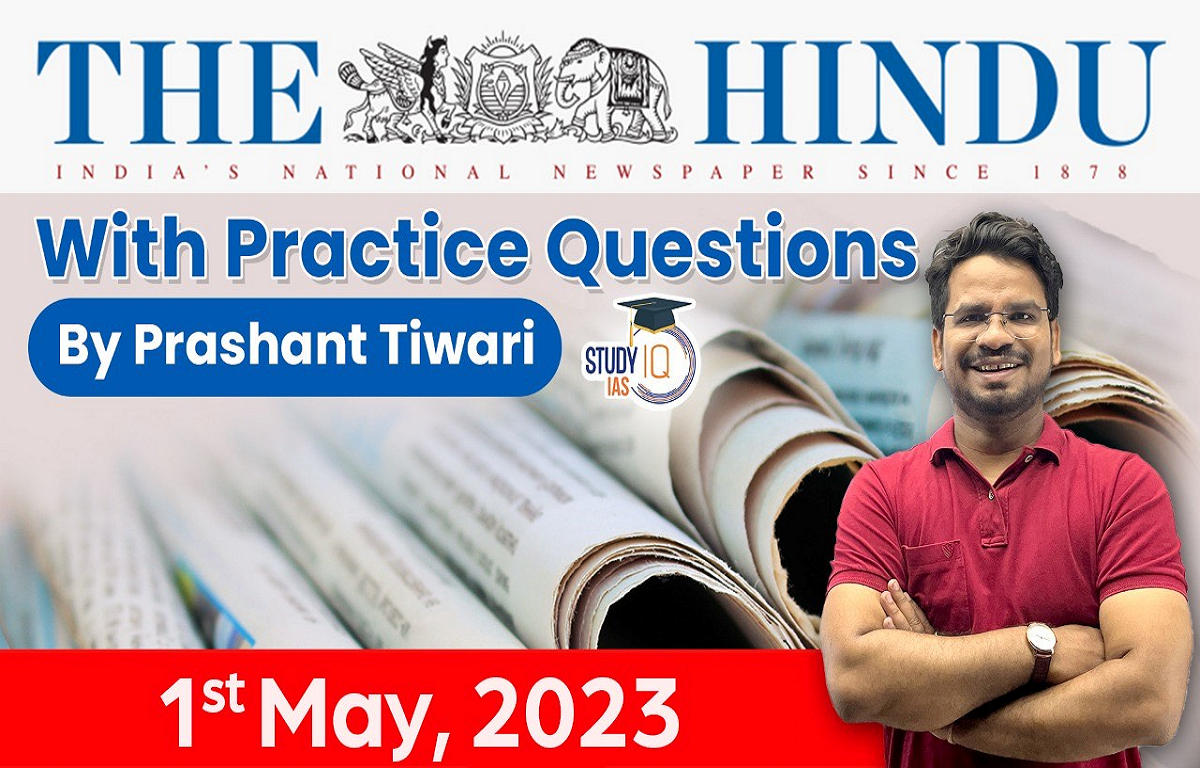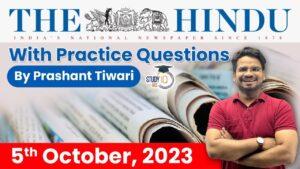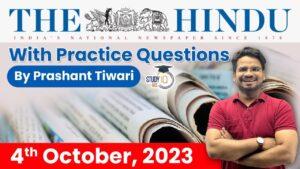The Hindu Newspaper Analysis for UPSC

The Hindu Newspaper Analysis 29 April 2023
- Shilabhattarika — the celebrated Sanskrit poetess of ancient India by establishing her as a daughter of the famed Chalukyan emperor Pulakeshin II of Badami (in modern Karnataka)..
- now reasonably certain that Shilabhattarika was a Chalukyan princess, possibly the daughter of Pulakeshin II, who ruled from 610-642 CE and had defeated Harshavardhan of Kanauj in a battle near the banks of the Narmada river in 618 CE.
- The Sanskrit poet-critic Rajashekhara, who lived in the 9th-10th century CE and was the court poet of the Gurjara-Pratiharas, had praised Shilabhattarika for her elegant and beautiful compositions.
- Noted Marathi poetess Shanta Shelke too has drawn inspiration from Shilabhattarika’s verses to compose one of her most iconic songs— toch chandrama nabhat (it is the same moon in the sky).
- The decoding of the copper plates also marks a notable shift in the historiography of Badami Chalukyas by placing Shilabhattarika as having lived in the 7th century CE rather than the current theory which has her as the wife of the 8th Century Rashtrakuta ruler Dhruva..

- Thrissur Pooram is an annual Hindu festival held in Kerala. It is celebrated on the day when the star sign “Pooram” occurs in the Malayalam month of “medam (April-May)”.
- The festival was the brainchild of Raja Rama Varma, famously known as Sakthan Thampuran, the Maharaja of Cochin (1790–1805).
- Pooram officially begins with Kodiyettam (flag hoisting ceremony) in which all the participating temples of the festival are present.
- The Pooram consists of ten temples in and around Thrissur and is considered to be a ceremony where these deities come together to pay obeisance to Lord Shiva at the Vadakkunnathan Temple, located in the centre of the town.
- One of the hallmarks of the festival is the percussion ensemble consisting of traditional instruments like chenda, maddalam, edakka, thimila and kombu.
- The seventh day of the pooram is the last day. It is also known as “Pakal Pooram”.



- May 1 is widely known as Labour Day, a day when we celebrate the contribution of workers worldwide. It is a moment for pride, celebration and hope.
- Globally, real wages have fallen, poverty is rising, and inequality seems more entrenched than ever. Enterprises have been hard hit. Many could not cope with the cumulative effects of recent unexpected events. Small and micro-enterprises were particularly affected, and many have ceased operations.
- People feel that the sacrifices they made to get through COVID-19 have not been recognised, let alone rewarded. Their voices are not being heard clearly enough. This, combined with a perceived lack of opportunities, has created a disturbing level of mistrust.
- The most effective way to do this is by providing quality jobs so that people can support themselves and build their own futures — ‘Decent Work for All’, as Sustainable Development Goal 8 terms it.
About ILO:
- Established as an agency for the League of Nations following World War I.
- Established by the Treaty of Versailles in 1919.
- It became the first specialised agency of the United Nations (UN) in the year 1946.
- It got the Nobel Peace Prize in 1969.
- It is the only tripartite U.N. agency. It brings together governments, employers and workers.
- Headquarters: Geneva, Switzerland.
Key reports:
- World Employment and Social Outlook.
- Global Wage Report.

- Defence Minister Rajnath Singh’s message to his visiting Chinese counterpart General Li Shangfu, that Beijing’s violation of border agreements had “eroded the entire basis of bilateral relations”, has once again served as a reminder of how the two neighbours remain far apart in their assessments of what ails their relationship, and how to fix it.
- Over the past three years, buffer zones have been established in some of the five friction areas where the two sides disengaged. In two other areas, Demchok and Depsang, Beijing has dragged its feet, slowing down the initial momentum of the Corps Commander meetings.
- The 18th round, held days before the Chinese Defence Minister’s arrival and after an unexplained four month-delay following the previous round, did not yield a joint statement, suggesting stark divergences remain on how to move forward. De-escalation, meanwhile, remains a far-off prospect.

POSH Act:
- The Sexual Harassment of Women at Workplace (Prevention, Prohibition and Redressal) Act was passed in 2013, defining sexual harassment, laying down the procedures for a complaint and inquiry, and the action to be taken.
Constitutes:
- It defines sexual harassment,
- lay down the procedures for a complaint and inquiry, and
- the action to be taken.
Successor to:
- It broadened the Vishaka guidelines, which were already in place.
Vishaka Guidelines
- About:
- The Vishaka guidelines were laid down by the Supreme Court in a judgement in 1997.
- This was in a case filed by women’s rights groups, one of which was Vishaka.
PIL:
- They had filed a public interest litigation (PIL) over the alleged gangrape of Bhanwari Devi, a social worker from Rajasthan.
- In 1992, she had prevented the marriage of a one-year-old girl, leading to the alleged gangrape in an act of revenge.
SHe-Box
- The Ministry of Women & Child Development had launched Sexual Harassment electronic Box (SHe-Box) to provide single window access to every woman, irrespective of her work status, whether working in the organized or unorganized, private or public sector, to facilitate the registration of complaint related to sexual harassment.
- Any woman facing sexual harassment at the workplace can register their complaint through this portal.
- Once a complaint is submitted to the ‘SHe-Box’, it will be directly sent to the concerned authority having jurisdiction to take action into the matter.

- In 1919, the International Labour Organization adopted the Hours of Work (Industry) Convention, which limited the number of working hours to eight a day and 48 hours a week. British India ratified the Convention on July 14, 1921.
- When COVID-19 hit India, several States amended the Factories Act, 1948, using the ordinance route. Recently, the Tamil Nadu and Karnataka governments also increased the number of working hours a day. Following opposition, the Tamil Nadu government put a hold on the amendment to the Factories Act on work hours.
- In India, mainstream economists give the green signal to any initiative as long as it increases exports, even if it is at the cost of labour rights and human rights.
- In 2022, according to the Global Right Index, launched by the International Trade Union Confederation (ITUC), Bangladesh ranked among the 10 worst countries where labour rights are not guaranteed.

- In Gujarat, as per the figures shared by the State government in the Assembly recently, as many as 11 people died while cleaning sewer lines in last two years before these eight deaths that have been reported recently.
- Manual scavenging refers to the practice of manually cleaning, carrying, disposing or handling in any manner, human excreta or any kind of dry or wet waste from insanitary latrines, open drains, septic tanks or other similar places.
- Manual scavenging is a dehumanizing practice that involves the use of basic and often unsafe tools like brooms, buckets, and baskets, which can lead to serious health hazards, injuries, and even death.
Steps taken by the government to curb manual scavenging:
- The government has formulated the NAMASTE scheme or National Action Plan for Mechanised Sanitation Ecosystem in an effort to stop deaths due to hazardous cleaning of sewers and septic tanks,
- The Employment of Manual Scavengers and Construction of Dry Latrines (Prohibition) Act, 1993 was introduced to ban manual scavenging.
- The Prohibition of Employment as Manual Scavengers and Their Rehabilitation Act, 2013 to further reinforce the ban and to provide for the rehabilitation of people employed as manual scavengers.
- In 2014, the Supreme Court directed the government to take several measures including:
- One-time cash assistance to people employed as manual scavengers
- Houses for manual scavengers
- Training in livelihood skills for at least one member of their families
- Concessional loans to prop them up financially and find an occupation
- Payment of ?10 lakh in compensation in the case of sewer deaths
- Despite the legal prohibition and government efforts to eradicate manual scavenging, the practice still persists in various parts of the country.
Q) Which of the following committees does not have members form the Rajya Sabha?
- Committee on Public Undertakings (COPU)
- Public Accounts committee (PAC)
- Estimates Committee
- Committee on the Welfare of Scheduled Castes and Scheduled Tribes
निम्नलिखित में से किस समिति में राज्य सभा के सदस्य नहीं होते हैं?
- सार्वजनिक उपक्रमों पर समिति (COPU)
- लोक लेखा समिति (PAC)
- प्राक्कलन समिति
- अनुसूचित जातियों और अनुसूचित जनजातियों के कल्याण संबंधी समिति
- The Estimates Committee (India)is a committee of selected members of parliament, constituted by the Parliament of India (the Lok Sabha), for the purpose of scrutinising the functioning of government ministries and departments in terms of expenditure and utilisation of funds.
- It also suggests alternative policies in order to bring about efficiency and economy in administration.
- It also examines whether the finances are laid out within the limits of the policy implied in the estimates and also to suggest the form in which the estimates shall be presented to Parliament. This committee along with the Public Accounts committee (PAC) and Committee on Public Undertakings (COPU) are the three financial standing committees of the Parliament of India.
The committee consists of thirty members, all elected from Lok Sabha. There are no members from Rajya Sabha.
Q) Consider the following statements
- In the Berubari Union case, the Supreme Court opined that Preamble is part of the Constitution.
- In the Kesavananda Bharati case, the Supreme Court rejected the earlier opinion and held that Preamble is not part of the Constitution.
Which of the above statements is/are correct?
- 1 only
- 2 only
- Both 1 and 2
- Neither 1 nor 2
निम्नलिखित कथनों पर विचार करें
- बेरुबारी संघ मामले में, सर्वोच्च न्यायालय ने कहा कि प्रस्तावना संविधान का हिस्सा है।
- केशवानंद भारती मामले में, सर्वोच्च न्यायालय ने पहले की राय को खारिज कर दिया और कहा कि प्रस्तावना संविधान का हिस्सा नहीं है।
उपरोक्त कथनों में से कौन-सा/से सही है/हैं?
- केवल 1
- केवल 2
- 1 और 2 दोनों
- न तो 1 और न ही 2
Explanation:
- In the Berubari Union case (1960), the Supreme Court said that the Preamble shows the general purposes behind the several provisions in the Constitution, and is thus a key to the minds of the makers of the Constitution. Further, where the terms used in any article are ambiguous or capable of more than one meaning, some assistance at interpretation may be taken from the objectives enshrined in the Preamble. Despite this recognition of the significance of the Preamble, the Supreme Court specifically opined that Preamble is not a part of the Constitution.
- In the Kesavananda Bharati case17 (1973), the Supreme Court rejected the earlier opinion and held that Preamble is a part of the Constitution. It observed that the Preamble is of extreme importance and the Constitution should be read and interpreted in the light of the grand and noble vision expressed in the Preamble.
Q) With reference to the Food Safety and Standards Authority of India, consider the following statements:
- It is a statutory body established under the Food Safety and Standards Act, of 2006.
- It works under the Union Ministry of Consumer Affairs, Food and Public Distribution.
Which of the above statements is/are Incorrect?
- 1 only
- 2 only
- Both 1 and 2
- Neither 1 nor 2
भारतीय खाद्य सुरक्षा और मानक प्राधिकरण के संदर्भ में निम्नलिखित कथनों पर विचार कीजिये:
- यह 2006 के खाद्य सुरक्षा और मानक अधिनियम के तहत स्थापित एक वैधानिक निकाय है।
- यह केंद्रीय उपभोक्ता मामले, खाद्य और सार्वजनिक वितरण मंत्रालय के तहत काम करता है।
उपरोक्त में से कौन सा/से कथन गलत है/हैं?
- केवल 1
- केवल 2
- 1 और 2 दोनों
- न तो 1 और न ही 2
Explanation :
Recently, the Food Safety and Standards Authority of India (FSSAI) has undertaken to translate Food Safety and Compliance System (FOSCOS) into Hindi, followed by all the regional languages.
- The Food Safety and Compliance System is an enhanced version of the Food Licensing and Registration System (FLRS) which was launched in 2012 for the issuance of pan-India FSSAI Licenses and Registration.
- It is a comprehensive system for registration and licensing for Food Business Operators (FBOs).
- It is a statutory body established under the Food Safety and Standards Act, 2006 (FSS Act).
- FSS Act, of 2006 consolidated various acts & orders that had earlier handled food-related issues in various Ministries and Departments.
- Nodal ministry: Ministry of Health & Family Welfare.
- Some of the Initiatives of FSSAI
- Heart Attack Rewind: It was launched for the elimination of industrially produced trans-fat in the food supply.
- It will support FSSAI‟s global target of eliminating trans-fat in India by the year 2022.
- Eat Right India movement: It is an initiative to transform the country’s food system to ensure safe, healthy and sustainable food for all Indians.
Q) Consider the following statements about the Shanghai Cooperation Organisation (SCO):
- It is the second largest organization after the United Nations.
- Heads of State Council (HSC) is the supreme decision-making body in the SCO.
Which of the above statements is/are correct?
- 1 only
- 2 only
- Both 1 and 2
- Neither 1 nor 2
शंघाई सहयोग संगठन (एससीओ) के बारे में निम्नलिखित कथनों पर विचार करें:
- यह संयुक्त राष्ट्र के बाद दूसरा सबसे बड़ा संगठन है।
- स्टेट काउंसिल के प्रमुख (HSC) SCO में सर्वोच्च निर्णय लेने वाली संस्था है।
उपरोक्त कथनों में से कौन-सा/से सही है/हैं?
- केवल 1
- केवल 2
- 1 और 2 दोनों
- न तो 1 और न ही 2
Explanation:
- The Organisation of Islamic Cooperation (OIC) is the second largest organization after the United Nations.
- About the Shanghai Cooperation Organisation (SCO):
- It is a permanent intergovernmental international organisation.
- It’s creation was announced on 15 June 2001 in Shanghai (China) by the Republic of Kazakhstan, the People’s Republic of China, the Kyrgyz Republic, the Russian Federation, the Republic of Tajikistan, and the Republic of Uzbekistan.
- It was preceded by the Shanghai Five mechanism.
- The Shanghai Cooperation Organisation Charter was signed during the St.Petersburg SCO Heads of State meeting in June 2002, and entered into force on 19 September 2003.
- The SCO’s official languages are Russian and Chinese.
- HQ: Beijing, China
- Heads of State Council (HSC) is the supreme decision-making body in the SCO. It meets once a year and adopts decisions and guidelines on all important matters of the organisation.


 The Hindu Newspaper Analysis 6 October 2...
The Hindu Newspaper Analysis 6 October 2...
 The Hindu Newspaper Analysis 5 October 2...
The Hindu Newspaper Analysis 5 October 2...
 The Hindu Newspaper Analysis 4 October 2...
The Hindu Newspaper Analysis 4 October 2...

















